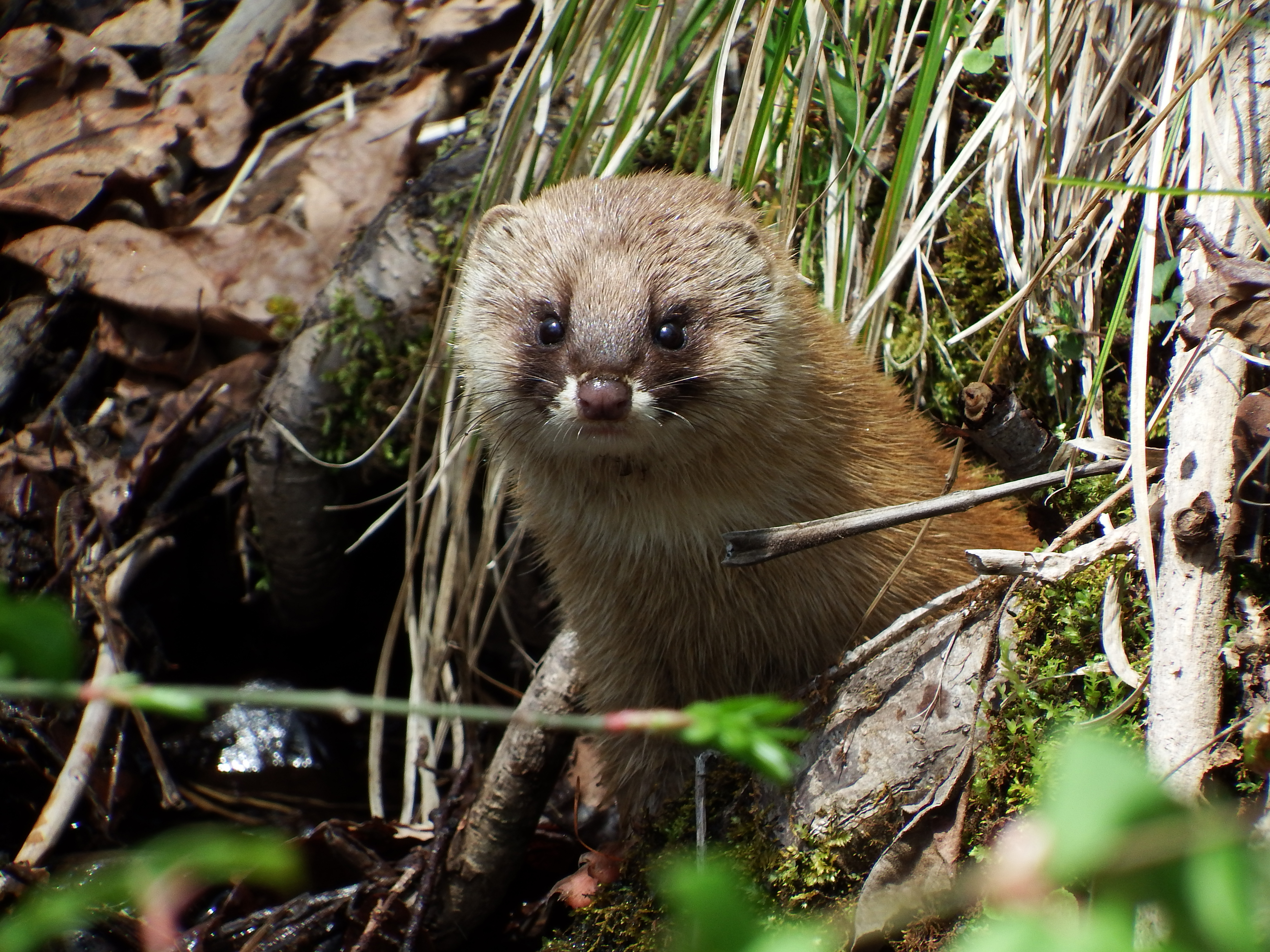One of the mammals we're most likely to see in our Afan woods up here in Kurohime in the Nagano Prefecture hills is the Japanese weasel (Mustela itatsi). These wonderful little animals, known as itachi in Japanese, are master hunters that can run, climb trees, swim and dive and take down birds or other animals more than twice their size — which makes them pretty unpopular with chicken farmers!
Weasels have lithe and slender bodies up to 35 cm long in the case of males, which are larger than females, though both sport tails about half as long again — and they all have rather short legs with sharp claws. However, when they go for the kill, usually to the neck of their prey, weasels bite deep and then hang on.
These are attractive animals, very curious, with orange-brown fur that becomes fine and glossy in winter. They usually have a white bib and darker markings on the head.
The weasel family (Mustelidae) is represented pretty well all over the world except Australia, and some species of weasels turn white in winter. Ours here in northern Nagano don't change color despite the many meters of snow we get every winter — when they spend much of the time hunting through the maze of tunnels that mice and voles make, half roofed in snow, the rest in grass, dead leaves and soft earth.
Weasels can hunt animals as big as rabbits — which don't exist in the wild in Japan, though hares do, and weasels will prey on juveniles. They are also partial to pheasants, quails (not to mention those chickens, or ducks if available), small birds in general, rodents, frogs, insects, some freshwater crustaceans and fish — and they will also eat seeds, fruits and berries.
Our now-retired forester, Mr. Matsuki, used to tickle (catch by hand) wild char in our streams and put them in the pond dug close by the charcoal kiln to fatten them up. The char tended to disappear very quickly, and he swore it was the weasels that took them. Certainly the pond was too deep for herons, but too small for the cormorants that fish on our larger ponds.
Female weasels usually have one litter a year numbering five or six kits that are weaned in eight weeks. Along with owls and snakes, these carnivores are very welcome in our woods as they help to control the huge numbers of mice and voles. Cute little creatures those rodents may be, but they're responsible for a lot of tree saplings killed during the winter when the pesky little critters chew on the roots at a time when snakes are hibernating and owls can't hunt under the snow.
Although they are fierce little fighters, weasels fall prey to hawks and owls, although mammalian predators are supposed to be put off by their very musky scent which is similar to that of a skunk — but nowhere near as strong an odor.
Interestingly, that scent gives rise to the Japanese saying itachi no saigo-pei — which translates literally as "the weasel's final fart," but is very often used to mean the last words or efforts of a usually unpopular or unsavory person.
Another very common Japanese expression is itachi gokko ("weasel play"), which means to go on repeating the same things — a vicious circle. When on Earth weasels are supposed to do this, I do not know.
Which brings me to the many ways in which the name or inferred character of the weasel is commonly vilified in the English language.
Look up "weasel" in a dictionary and you'll find one meaning given as "a dishonest person who cannot be trusted." If you call somebody a "weasel," you probably mean that he or she is sneaky, given to fudge, hedge, pussyfoot, waffle, equivocate, renege, be evasive, avoid giving a definite answer and/or to tergiversate (I love that word!).
Wild weasels, as far as I can see, are guilty of none of this.
However, in Japanese and Japan's legends, weasels are often given the mucky end of the stick. It was believed that seeing a weasel was an omen of bad luck, even death — while someone might be called a "weasel (itachi)" if they are thought to be the sort who swaggers with bravado when there's nobody else stronger or superior in status around. Wild weasels don't do that.
Like foxes and tanuki raccoon dogs, weasels in Japanese legend are also believed to be shape-changers capable of metamorphosing into mischievous little monks. Well in our woods we've seen lots of weasels, or the same weasels many times — but never yet any mischievous little monks.
Similarly improbable, or just plain daft, is another Japanese countryside legend which has it that after reaching the age of 100, weasels turn into ten (martens). Nonetheless, whether superannuated weasels or not, the Japanese marten or sable (Martes melampus) is also quite a common species in our woods — a beautiful animal with a white face and gorgeous orange fur that used to be very much in demand.
When I was a boy growing up in Britain, I had a friend, a farmer's son, whose family kept ferrets. Said to have been domesticated from the European polecat more than 2,500 years ago, these animals are a bit bigger than weasels. With humans they accept, they are quite tame, and my friend's family kept several together in cages and would often bring them out to play with and fondle. Mind you, if a ferret didn't like you it could give you one hell of a nip!
Back then I used to help when the men and boys of the family went hunting rabbits with a ferret and dogs. The chosen ferret was muzzled, because there wasn't much point if it killed a rabbit in a burrow then spent the next 12 hours or so underground, gorging and snoozing.
When we got to a warren, we'd try to find all the holes and, using spades we'd taken with us, block some of them with earth while leaving the others with small string nets pegged over them. When everybody was ready, with the dogs off their leashes and us boys with cudgels tightly gripped, the eager ferret would be released down into a burrow.
Once it had vanished inside, it wouldn't be long before rabbits came bolting out of the holes, some into the nets where they were soon clubbed and bagged. Others inevitably found a hole or holes that'd been missed and darted into the open, chased by excited dogs and even more excited boys.
It was a great and indeed age-old way to get a lot of rabbits, and we cooked and ate all those we caught, with the innards shared by both ferrets and dogs.
Nowadays in Britain, though they are rarely used for hunting, ferrets have become very popular as pets. I've seen pet ferrets in Japan too, and although they are cute, and fun to keep, I wouldn't dream of bringing one to Kurohime. If it escaped, became feral and somehow survived, it could no doubt cause untold damage to local wildlife — as ferrets introduced to New Zealand have.
Here in northern Nagano, I'm happy just to watch our worthy weasels in the woods — while keeping a weather eye open for mischievous little monks.




















With your current subscription plan you can comment on stories. However, before writing your first comment, please create a display name in the Profile section of your subscriber account page.